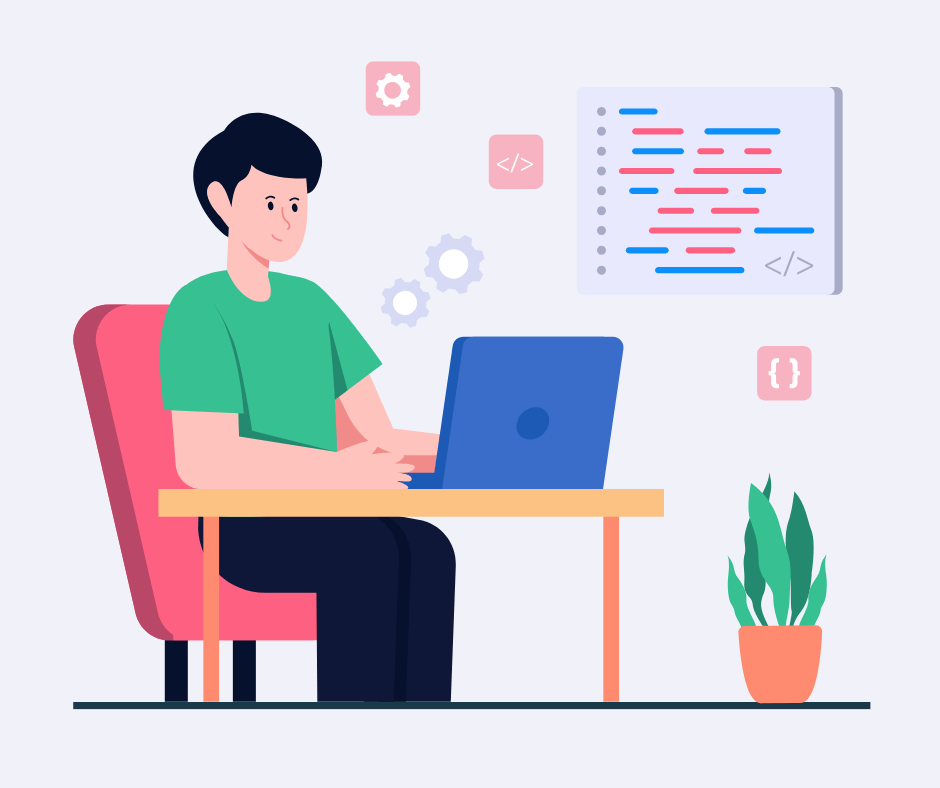The world of software development is growing rapidly, and full-stack development is one of the most in-demand skill sets today. Full-stack developers are the versatile professionals who can handle both front-end and back-end tasks, making them invaluable to teams and projects. But for beginners, stepping into full-stack developmentcan feel overwhelming due to the variety of skills and tools involved.
1. What is Full-Stack Development
Full-stack web development refers to the development of both the front end (client-side) and back end (server-side) of web applications. A full-stack web developer works on both the user-facing side (what users interact with) and the server side (how the application works and communicates with the database). The goal of a full-stack developer is to create a seamless user experience by managing everything from how the websitelooks to how it functions behind the scenes.
In general, full-stack development consists of:
Front-End Development: This includes everything users see and interact with on a website, often using HTML, CSS, and JavaScript, as well as frameworks like React or Angular.
Back-End Development: This is what powers the application behind the scenes, typically involving server-side languages like Python, Ruby, or Java, along with frameworks like Express or Django.
Database Management: Databases are used to store data that the application needs to operate. Common database options include SQL-based (like MySQL) and NoSQL-based (like MongoDB) systems.
2. Skills Needed for Full-Stack Web Development
Front-End Skills
HTML (HyperText Markup Language): HTML is the foundation of any web page, defining the structure of the content.
CSS (Cascading Style Sheets): CSS is used for styling and designing a web page, such as setting colors, fonts, and layouts.
JavaScript: JavaScript is essential for creating interactive web experiences, such as animations, dynamic content updates, and form validations.
Responsive Design: A full-stack web developer should know how to make applications look good on both desktop and mobile devices, using responsive frameworks or CSS techniques like Flexbox and Grid.
Front-End Frameworks: Learning a framework like React, Vue.js, or Angular is important for building scalable and efficient front-end applications.
Back-End Skills
Programming Languages: Popular languages include Python, JavaScript (Node.js), Ruby, PHP, and Java. Node.js, a JavaScript runtime, is commonly used for server-side programming.
Back-End Frameworks: Frameworks help structure and streamline server-side code. Examples include Express (Node.js), Django (Python), Ruby on Rails (Ruby), and Spring (Java).
API Development: APIs (Application Programming Interfaces) are crucial for connecting the front end with the back end. Knowledge of RESTful services and JSON is essential, along with experience using GraphQL.
Authentication and Security: Implementing security measures like HTTPS, JWT (JSON Web Tokens), and OAuth is essential for protecting applications and user data.
Server, Networking, and Hosting: Understanding how servers work, how to manage them, and how to deploy applications on platforms like Heroku, AWS, or Netlify can be beneficial.
Database Management
SQL (Structured Query Language): SQL databases (e.g., MySQL, PostgreSQL) are widely used for applications requiring structured data storage and relations.
NoSQL: For applications that need more flexibility or handle unstructured data, NoSQL databases (e.g., MongoDB) can be a good option.
Database Operations: Basic knowledge of CRUD operations (Create, Read, Update, Delete) is essential to manage data efficiently.
ORMs (Object-Relational Mappers): ORMs like Sequelize for Node.js and SQLAlchemy for Python help manage and interact with databases more efficiently.
Version Control
Git: Git is essential for managing code changes and collaboration. A full-stack developer should know the basics, such as committing, branching, merging, and handling pull requests.
GitHub/GitLab: These platforms are commonly used to host Git repositories and enable collaboration on projects, issue tracking, and CI/CD (Continuous Integration and Continuous Deployment).
3. Key Tools for Full-Stack Development
Front-End Tools
Text Editors/IDEs: Popular options include VS Code, Atom, and Sublime Text for writing and organizing code.
Browser Developer Tools: Built-in tools in Chrome, Firefox, and other browsers are essential for debugging front-end code
CSS Preprocessors: Sass and LESS help organize and simplify CSS, making it easier to maintain.
Back-End Tools
Node.js: A runtime environment for JavaScript, used to build back-end applications.
Express.js: A minimal and flexible Node.js framework for building web and mobile applications.
Django: A Python-based framework that provides a complete set of tools for building robust applications.
Spring Boot: A Java-based framework that simplifies the process of setting up and deploying applications.
Database and Storage Tools
MongoDB: A NoSQL database for applications requiring flexible, document-based storage.
MySQL/PostgreSQL: Popular SQL databases for handling relational data.
Firebase: A cloud-based backend that offers real-time database and storage, often used in simpler applications.
Version Control Tools
Git: Essential for source code management.
GitHub/GitLab/Bitbucket: Platforms for hosting and managing repositories, as well as for team collaboration and CI/CD.
Additional Useful Tools
Postman: An API testing tool that allows developers to test and debug their API endpoints.
Docker: For containerizing applications, making them easier to deploy and manage across different environments.
Webpack: A bundler that compiles JavaScript modules and other assets, streamlining front-end workflows.
4. Full-Stack Development Roadmap
1: Start with HTML, CSS, and JavaScript
The first step is to master the basics of HTML, CSS, and JavaScript. Begin by building simple web pages and experimenting with layouts, styles, and interactivity.
2: Dive into Front-End Frameworks
Once you feel comfortable with JavaScript, start learning front-end frameworks like React, Vue, or Angular. React is a popular choice due to its simplicity and flexibility.
3: Learn a Back-End Language and Framework
After mastering front-end frameworks, dive into back-end programming. Start with Node.js and Express if you are comfortable with JavaScript, or explore Django (Python) or Ruby on Rails.
4: Get Familiar with Databases
Learn the basics of databases and practice using both SQL (e.g., MySQL) and NoSQL (e.g., MongoDB) systems. Understand the differences and when to use each type.
5: Explore Version Control and Git
Version control is a crucial skill for collaboration and managing code history. Practice using Git commands and learn about branching, merging, and resolving conflicts.
6: Build and Deploy Your First Project
Select a project idea, such as a blog, e-commerce website, or portfolio, and start building it from scratch. This will help you practice combining front-end and back-end skills.
5. Final Tips for Beginners
Focus on Fundamentals: Don’t rush through learning the basics of HTML, CSS, and JavaScript. Solidifying your understanding here will make learning frameworks easier.
Build Projects: Practice is essential. Create small projects to apply your skills and gradually build larger, more complex applications.
Use Online Communities: Platforms like Stack Overflow, Reddit, and GitHub are invaluable for learning, asking questions, and connecting with other developers.
Stay Curious and Keep Learning: The tech world is always evolving. New tools, frameworks, and languages emerge, so keep learning even after mastering the basics.
Conclusion
Full-stack development is an exciting and rewarding field with boundless opportunities. While it can be overwhelming at first, having a structured roadmap and gradually building skills in both front-end and back-end areas will make the journey manageable. With dedication, continuous practice, and a solid foundation in the core concepts, you can become a capable and confident full-stack developer.



